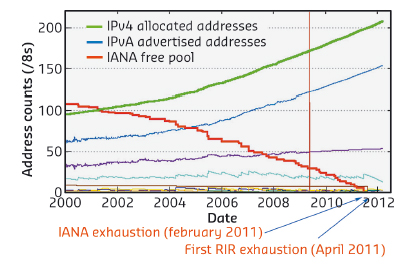- Home
- Users & Science
- Scientific Documentation
- ESRF Highlights
- ESRF Highlights 2014
- Enabling technologies
- IPv6 - Preparing the internet connectivity of the future
IPv6 - Preparing the internet connectivity of the future
The Internet Protocol (IP) is the main communication protocol in the Internet for relaying packets across networks and version 6 (IPv6) is the latest version [1]. IPv6 was developed by the Internet Engineering Task Force (IETF) to deal with the long-anticipated problem of IPv4 address exhaustion.
The depletion of IPv4 addresses was foreseen as long ago as the late 1980s. With the rapid growth of the Internet after commercialisation in the 1990s, the democratisation of Internet access in the developed world, the increasing use of mobile devices and buildings or home automation, the initial over-allocation managed by the Internet Assigned Numbers Authority (IANA) and by five Regional Internet Registries (RIR), and the inefficient address use by companies, are some of the reasons that have contributed to accelerate address consumption.
The top-level exhaustion occurred on 31 January 2011. Just three months later, on 15 April 2011, the APNIC (Asia-Pacific region) was the first RIR to run out of their free IPv4 address pool (Figure 157).
 |
|
Fig. 157: Exhaustion of IPv4 addresses. |
By 1998, the Internet Engineering Task Force had formalised the successor protocol IPv6. IPv6 uses a 128-bit address, allowing 2128, or approximately 3.4 × 1038 addresses, or about 1029 times as many as IPv4, which uses 32-bit addresses and provides approximately 4.3 billion addresses. IPv6 offers a virtually inexhaustible number of addresses and paves the way for connecting ubiquitous devices to the Internet, a trend lately branded as the “Internet of Things” where uniquely identifiable embedded computing devices are connected within the existing Internet infrastructure.
IPv6 is intended to replace IPv4, which still represents 95% of the Internet traffic worldwide. At the beginning of 2013, the percentage of users reaching Google services with IPv6 was just a little bit above 1% [2]. This shows the slow adoption of IPv6 by major Internet Service Providers (ISPs), home networking equipment manufacturers and companies around the world.
IPv4 and IPv6 protocols are not designed to be interoperable, complicating the transition to IPv6. However, several IPv6 transition mechanisms have been devised to permit communication between IPv4 and IPv6 hosts.
The “IPv6 Task Force France” (TTF) was created by the French Senate in 2002 to regroup main service providers and industrial actors to promote the use of IPv6 in France. It is part of the initiative launched by the European Commission to coordinate all IPv6 Task Forces in Europe.
Efforts made by the government and some other institutions that were involved have proved fruitful as France is currently among the top 20 countries using IPv6 (rated as fourteenth in the global classification).
RENATER [3], our National telecommunications network for Technology, Education and Research, is currently connecting more than 1000 sites (institutions, universities and French organisations), but only 174 of them have already applied for an IPv6 prefix. Furthermore, only 118 have already broadcast their prefix to the rest of the world. Rhône-Alpes is one of the most active regions just behind Île-de-France.
At the ESRF, IPv6 will not replace IPv4 in the short term. Instead both protocols must co-exist on the Internet for several years. Being IPv6 ready is important for sites like ESRF to guarantee that data transfers are not slowed down by heavy protocol translations. However, progressing towards the implementation of this new Internet protocol standard was a long and complicated procedure for the EPN-campus. There were significant hurdles to overcome; organisational as well as technical. Discussions on this subject between the different EPN participants started only in April 2013. IPv6 has a significant impact for the System Administrators of the campus laboratories because of some new features and default behaviours. In fact System Administrators have to learn a completely new internet protocol. Once administrative formalities to obtain the new IPv6 address space had been settled, there was still a long road ahead for EPN institutes to implement the new prefix assigned by RENATER: give external visibility to our new prefix through our metropolitan network (TIGRE), find new partners supporting the Domain Name Service (DNS), adapt several hardware and software components to support this protocol, and make an address plan to share this IPv6 prefix between the four institutes taking part: ESRF, ILL, EMBL, IBS.
The last component to be dealt with was the upgrade of the common EPN-site firewall. Discussions with different suppliers of security systems started as early as May 2013. But nonetheless, finding companies with sufficient experience of this kind of deployment over IPv6 was challenging. Finally, on 20 October 2014 everything was in place and the migration was performed with only 43 seconds of service interruption. Today, the firewall is able to support new security features over the dual IPv4 and IPv6 stack.
The ESRF is now ready for the next generation of Internet services based on IPv6!
Authors
F. Calvelo Vazquez and B. Lebayle.
ESRF
References
[1] Wikipedia entry on IPv6: http://en.wikipedia.org/wiki/IPv6
[2] Google’s statistics: http://www.google.com/intl/en/ipv6/statistics.html
[3] RENATER: https://www.renater.fr



